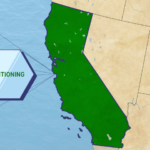Carbon Prices Reach New Highs, UK Launches ETS

Q2 2021 global carbon market highlights:
- The carbon price in the European Union’s emissions trading system (ETS) hit an all-time high of €56.90 (1 EUR = 1.1856 USD as of 6/30/2021) in May, and prices seem to have stabilized above the €50 mark.
- The United Kingdom launched a domestic emissions trading system as a result of the UK leaving the EU ETS following Brexit, and early trading showed a slight premium to the EU price.
- Carbon prices in California were also on the rise as the second auction of the year cleared at the highest-ever price for an allowance sale, with increased interest from investors.
- In April, President Biden hosted the Leaders’ Summit on Climate with leaders from countries around the world announcing commitments to address climate change. At the summit, President Biden announced that the United States would reduce greenhouse gas (GHG) emissions by 50% – 52% relative to the level of 2005 by 2030. The US also formally re-joined the Paris Agreement. Overall, if the pledges and commitments made by all countries at the Summit are accomplished, greenhouse gas emissions will fall by 2.6% – 3.7% more in comparison to the pledges before the summit.
Update on KRBN’s Carbon Market Exposure:
Prices rise to all-time high in Europe
Prices for the benchmark December 2021 European Union Emissions Trading System (EU ETS) contract rose to an all-time record of €56.90 in mid-May amid a surge of buying. A lack of compliance buyers at the higher prices calmed the market somewhat and prices consolidated above €50 as traders await the delivery of free 2021 allowances to industrial plants.
European carbon prices reached a new record high in May, surging through the €50/ton barrier for the first time and raced all the way to €56.90 on May 14. In just six months, carbon allowance prices in the EU more than doubled as investors crowded into the market, anticipating tighter supply and even higher prices to come.
Carbon permits have since consolidated and traded between €49-53/ton as participants absorb developments such as the start of the UK Emissions Trading System, uncertainties around the issuance of 2021 allowances to industrial plants, as well as the looming publication of the European Commission’s far-reaching reform plans for the EU ETS.
Prices ended May up nearly 22% from the end of March at €51.70.
Buying activity from compliance companies slowed as market prices rose above €50, but have since shown they are prepared to buy if prices dip close to or below €50. This suggests that the €50 mark is seen as the “new normal” by many market participants, despite complaints from some industrial sectors that they are no longer profitable at these prices.
According to data from ICE Futures, investment fund holdings currently represent 6.6% of the total long positions on the exchange, down slightly from their highest level at the start of May.
In an interview on May 7, European Commission vice-president Frans Timmermans, who leads the bloc’s climate policy, commented on whether the regulator would step in to calm prices. “It’s a market mechanism, but if we want to achieve our goals, I think the price should be much higher than it is, even at €50. But that’s up to the market,” Timmermans toldReuters.
Analysts at Bloomberg New Energy Finance predict European Union Allowance (EUA) prices will trade between €40-60 over the next few years, before advancing to around €108/t as emissions reductions opportunities in the power sector are exhausted and the focus switches to more expensive reductions in heavy industry.
About the European Union Emissions Trading System (EU ETS): The EU ETS is a cornerstone of the EU’s policy to combat climate change and its key tool for reducing greenhouse gas emissions cost-effectively. It is the world’s first major carbon market and remains the biggest one. The EU ETS operates in all EU countries plus Iceland, Liechtenstein and Norway.
California carbon auction clears at all-time high
The California Cap-and-Trade (CCA) market was electrified by the strong demand that generated the highest auction price ever seen. Futures prices rose briefly to more than $20/ton and looked set to challenge the record high of just below $21/ton. California permit prices ended the month of May 7.6% higher from the end of March at $19.93.
California and Quebec held their second joint auction of the year on May 19: the sale was a sell-out, with nearly 80m California and Quebec Carbon Allowances (CCAs and QCAs) knocked down at the highest price for an auction since the market launched in 2012. The sale cleared at $18.80/ton, well above expectations and more than $1 higher than the auction floor price.
The sale included volumes from previous unsuccessful auctions, demonstrating that there is a growing appetite for California Carbon Allowances (CCAs). According to the sale data, non-compliance entities such as investment funds bought more than 20% of the CCAs on offer (about 14 million permits), their highest ever share.
We believe that there is more potential demand for CCAs from investors who did not register for the May sale in time, and that the next auction, scheduled for August 18, could see even more non-compliance bidding.
The increased interest in the December futures contract also could reflect a more bullish fundamental picture for the rest of the year as well as the anticipation that inflation will rise in 2021. Because California’s auction reserve price increases by 5% a year plus inflation, changes in the Consumer Price Index will affect the auction price.
Prices in the secondary market also rose well above the auction level: the benchmark December 2021 futures contract closed on May 28 at $19.93/ton, suggesting that traders see the potential for prices to rise even higher. Earlier in the month, the December price rose as high as $20.25/ton.
About the California Cap-and-Trade system (CCA): The California program, which is implemented by the California Air Resources Board (CARB), covers sources responsible for approximately 80% of the state’s GHG emissions. The first compliance obligations started in January 2013. California has been part of the Western Climate Initiative since 2007 and formally linked its system with Québec’s in January 2014.
Regional Greenhouse Gas Initiative (RGGI) prices dip
Prices in the northeast’s cap-and-trade market slid 0.9% over the last two months to end May at $7.91/short ton, as traders readied themselves for the second auction of the year.
Activity and prices in the RGGI market dropped away during the months of April and May as participants readied themselves for the market’s second auction of the year, which occurred on June 2. The member states sold nearly 23 million Regional Greenhouse Allowances (RGAs), with a floor price of $2.38/short ton.
The first sale of 2021 cleared at $7.60/st, and futures prices rose above $8/st earlier in the quarter, but drifted lower as the auction neared. The December 2021 futures market ended May at $7.91/st, a drop of 9 cents (1.1%) from the end of April.
Environmental groups are petitioning North Carolina governor Roy Cooper to consider joining RGGI.
About Regional Greenhouse Gas Initiative (RGGI): The Regional Greenhouse Gas Initiative is a joint effort for Connecticut, Delaware, Maine, Maryland, Massachusetts, New Hampshire, New Jersey, New York, Rhode Island, Vermont and Virginia, and the first mandatory, market-based carbon dioxide emissions reduction program in the United States.
New Carbon Markets:
UK launches domestic carbon market*
The UK launched its own domestic carbon market at the end of May. Prices for UK emissions Allowances (UKAs) are holding at a premium to EU permits in the early days of the newest market. The benchmark UKA price ended May €5 higher than its EU counterpart.
The UK ETS was built to replace the country’s membership in the EU system after Brexit, and is identical to the EU market in many respects. The government auctions UK Allowances (UKAs) and also hands out UKAs free to industry at risk of carbon leakage.
There are mechanisms to cut oversupply or to calm prices in the event of a sharp spike. The allocation of allowances for 2021 was based on what would have been the UK’s target in the EU system. A total of 39 million UKAs were issued to installations ranging from food processing plants to steel mills, while the government will also sell 83 million allowances, primarily targeting utilities who get no free allocation.
There are some differences to the EU market, notably a floor price for auctions at £22/ton (1 GBP =1.3828 USD as of 6/30/2021), and the cost containment mechanism has been calibrated to be more responsive in the first year of the market, to ward off any price spikes.
About the UK Emissions Trading Scheme: The UK Emissions Trading Scheme (UK ETS) replaced the UK’s participation in the EU ETS when the UK left the EU. The scheme puts a cost on carbon pollution to encourage polluters to reduce the amount of greenhouse gases they emit.
On the Radar: Important Milestones and Events for Q3 and Beyond
European Union Emissions Trading System (EU ETS)
- End June / early July: the EU ETS issues free allowances (EUAs) to industrial installations at risk of leakage.
- July 14 European Commission publishes draft legislation for reform of EU ETS to meet its new 2030 emissions goal. Also expected to publish its draft legislation for a carbon border adjustment mechanism.
California Cap-and-Trade System (CCA):
- June 18: ARB published notice document for August allowance auction.
- July 6: ARB published quarterly compliance instrument report.
Regional Greenhouse Gas Initiative (RGGI):
- September 8: RGGI allowance auction takes place.
*The UK Emissions Trading Scheme is not currently an investment option for KRBN.


















